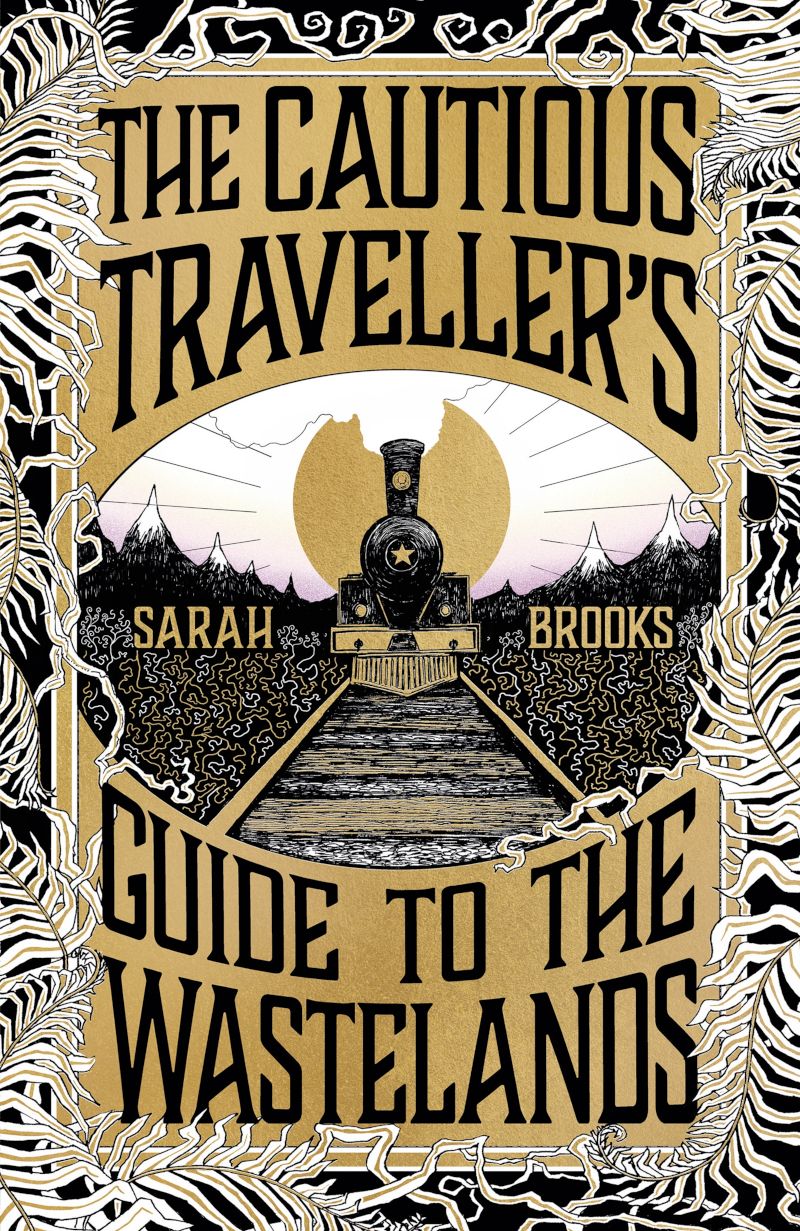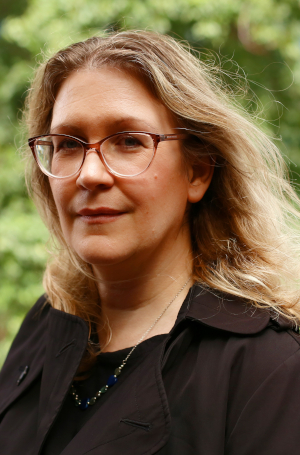Click here to return to the world eco-fiction series
About the Book
“Vividly imagined and deftly paced, The Cautious Traveller’s Guide to the Wastelands asks us to reconsider our place within the natural world amid a backdrop of capitalism and empire. Brooks has penned an elegant novel that is at once thrilling and transcendent. Also, there is a really cool train.” -Rita Chang-Eppig, author of Deep as the Sky, Red as the Sea
There is only one way to travel across the Wastelands: on the Trans-Siberian Express, a train as famous for its luxury as for its danger. The train is never short of passengers, eager to catch sight of Wastelands creatures more miraculous and terrifying than anything they could imagine. But on the train’s last journey, something went horribly wrong, though no one seems to remember what exactly happened. Not even Zhang Weiwei, who has spent her life onboard and thought she knew all of the train’s secrets.
Now, the train is about to embark again, with a new set of passengers. Among them are Marya Petrovna, a grieving woman with a borrowed name; Henry Grey, a disgraced naturalist looking for redemption; and Elena, a beguiling stowaway with a powerful connection to the Wastelands itself. Weiwei knows she should report Elena, but she can’t help but be drawn to her. As the girls begin a forbidden friendship, there are warning signs that the rules of the Wastelands are changing and the train might once again be imperiled. Can the passengers trust each other, as the wildness outside threatens to consume them all?
Chat with the Author
Mary: Thanks so much for talking with Dragonfly, Sarah! I recently learned about your novel The Cautious Traveller’s Guide to the Wastelands, which was published by W&N at Orion Publishing Group in June of this year. Can you sum up the novel for our readers?
Sarah: The Cautious Traveller’s Guide to the Wastelands is a historical fantasy, set at the end of an alternative nineteenth century, and follows the passengers and crew on board the great Trans Siberian Express—an armoured train that makes its way across what was once Mongolia and Siberia, but is now the dangerous and ever-changing landscape of the Wastelands. The powerful Trans-Siberia Company assures the passengers and crew that the journey is safe, but they have their own reasons for wanting the train to run, whatever the dangers.
Mary: Three main characters embark on a journey aboard the Trans-Siberian Express, which crosses the Siberian tundra. They depart from China and head to Moscow. I love these characters: a mysterious woman, Marya Petrovna; a naturalist wanting to catalog the Wastelands, Henry Grey; and a teenager who has lived on the train since birth, Zhang Weiwei. The way the characters evolve and add to the big picture seems fascinating. Can you talk some about these characters and how each brings a unique element to the story?
Sarah: I wanted each of the main characters to have a different relationship to the train and to the Wastelands. Weiwei is the ‘child of the train’, who has always seen it as her home, and always trusted it to protect her from the dangers outside—she’s sure about the strength of its walls. But she’s beginning to question her loyalties, and an encounter with a strange stowaway starts to change her understanding of the world both inside and outside the train. I enjoyed imagining what it would be like to grow up in these unusual surroundings, and her part of the novel is a kind of coming-of-age story.
Marya has boarded the train under a borrowed name, and needs to keep her identity secret from the Trans-Siberia Company, whilst she tries to uncover their part in her family’s tragedy. Her point of view is perhaps closest to the reader’s experience of the train and the Wastelands—she’s experiencing it all for the first time, and she’s wary and distrustful. But she was also fun to write because I think she embodies some of the different aspects of travel— that you can be both frightened by something and fascinated by it at the same time.
And Henry Grey is inspired in part by the figure of the Victorian scientist/ explorer, who goes forth and claims land/ things/ people for himself. In early drafts of the book he started out as much more of a villain, but in the final version I hope he’s something a bit more nuanced — I wanted to explore some of the ways in which the desire for knowledge, and to get close to the natural world, which might seem at first to be positive goals, can be warped into something much more harmful.
So all the characters see the landscape in a different way, whether it’s something to be overcome, feared, or exploited. And then there’s the introduction of a different character, a little further into the book, who complicates these relationships.
Mary: The novel crosses genres. I’ve seen it described as historical fantasy, eco-fiction, and with elements of steampunk. Some of its subjects include friendship, transformation, nature, and more. Do you like being bound to genres, or would you rather, like in this book, spread out?
Sarah: I love reading within different genres, so I’m happy to mix them all up! I started writing this novel a long time ago (it began as a short story in, ahem, 2012…), so it’s ended up being fed by all sorts of things during that time. And I think it maybe reflects a lot of the books and genres I’ve loved since being very young. As a young teenager some of the first ‘grown-up’ books I was encouraged to read by my parents were Terry Pratchett, the Brontë sisters, and Agatha Christie, along with vast amounts of epic fantasy, and I’m really grateful for this open-minded approach!
Mary: A review by Library Journal said, “If a luxury train raced through Jeff VanderMeer’s Area X, filled with the cast of Frances Hardinge’s The Lie Tree, it would be something like the Trans-Siberian Express of this story…Ultimately, this journey through the unknown provides ample opportunity for musings about the power of travel to change people, while examining humans’ relationships to the environment, to capitalism, and to each other…A nerve-wracking but empathetic first-class read for lovers of the strange and uncanny.” This fascinated me, as I was a huge fan of Area X and the eco-weird elements of that story. How do the wastelands compare?
Sarah: I’m also a huge fan of Jeff VanderMeer, and the way that his novels twist the familiar into something uncanny and uncertain. I loved the way that the Area X books were about thwarted exploration, in many ways, and that the changed flora and fauna within them resist explanation. I was also keen not to present the Wastelands as a mystery that could be ‘solved’, although the ‘The Cautious Traveller’s Guide’ (the book within the book) does point to the land being exploited and fought over, and the changes beginning. I also read Merlin Sheldrake’s brilliant Entangled Life whilst I was writing the novel, and got even more into fungi and ideas about connections and communication within the natural world. I wanted the novel to have one foot firmly in the real world, but to imagine some of the ways that a landscape might rebel against human incursion.
Mary: Dragonfly explores themes such as ecosystems within fiction that show how humans connect to our natural landscapes and how those ecosystems are imagined without humans. Can you explain why you think it’s important to capture such themes in fiction, and explain some potential windows we explore nature from?
Sarah: I definitely feel that it’s almost impossible to write (or just exist) today without feeling the weight of the ecological stakes, and although I didn’t necessarily set out to write eco-fiction, the relationship between the natural landscape and the human world became more and more prominent as the drafts of the novel progressed. It was interesting to explore this from the point of view of an alternative nineteenth century, with quite a lot of extrapolation from real historical events or developments. For example, one of the inspirations for the Trans-Siberia Company in the novel was organisations like the British East India Company, who were hugely powerful and hugely exploitative, of both people and of the natural world. So I think historical fantasy can be a useful way of looking at both the past and the present, and questioning the ways in which human relationships with the natural world have changed or continued.
Another important influence on the novel was my PhD, which was on a seventeenth century Chinese writer, Pu Songling, who wrote an amazing collection of stories about all kinds of ghosts, animal spirits, and other strange phenomena. One of the things I loved about the stories was how they played with the connections between the human, natural, and supernatural worlds. There’s much less of a separation between the worlds than there is in European ghost stories, for example, and so provides a really interesting window through which to think about current understandings of our relationship with nature. This blurring of the boundaries between the human and the natural worlds—and the way it can seem both fearful but also wondrous—was very much something I wanted to explore in my book.
Mary: Is there anything else I didn’t cover that you would like to discuss?
Sarah: I’d just love to mention a couple of brilliant eco-fictional novels that I’ve enjoyed recently! Eliza Chan’s Fathomfolk is set in a semi-submerged city, and inspired by watery folklore from East Asia and elsewhere. It’s really incisive in its representation of politics and prejudice, but it’s also got a strong eco-fictional element, and very much shows the ways in which the harms done by prejudice and environmental damage go hand in hand. And I love the work of Marian Womack—I think her novel The Swimmers would be called eco-gothic, and looks at a future Earth transformed by climate change. She’s also very much influenced by Jeff VanderMeer, but also by Jean Rhys’s Wide Sargasso Sea.
And I’m also co-editor of a bilingual magazine of speculative fiction—Samovar, which is part of Strange Horizons—and we’ve had some really great stories with strong environmental themes, including ‘Panorama People‘, by Azrin Fauzi, translated by Ali Aiman Mazwin, and ‘Mysteries of Visiocherries‘, written and translated by Rio Johan. I hope readers of this site will enjoy them too! Thanks so much for inviting me to chat!
Mary: I love reading about fiction you enjoyed and recognize them; Fathomfolk is one I’ve purchased that I’m looking forward to! Thanks so much for the conversation; your book is brilliant!
About the Author
Sarah Brooks is a writer living in Leeds, England. She won the Lucy Cavendish Prize in 2019 and a Northern Debut Award from New Writing North in 2021. She works in East Asian Studies at the University of Leeds, where she helps run the Leeds Centre for New Chinese Writing. She is coeditor of Samovar, a bilingual online magazine for translated speculative fiction. The Cautious Traveller’s Guide to the Wastelands is her debut novel and will be published around the world.

